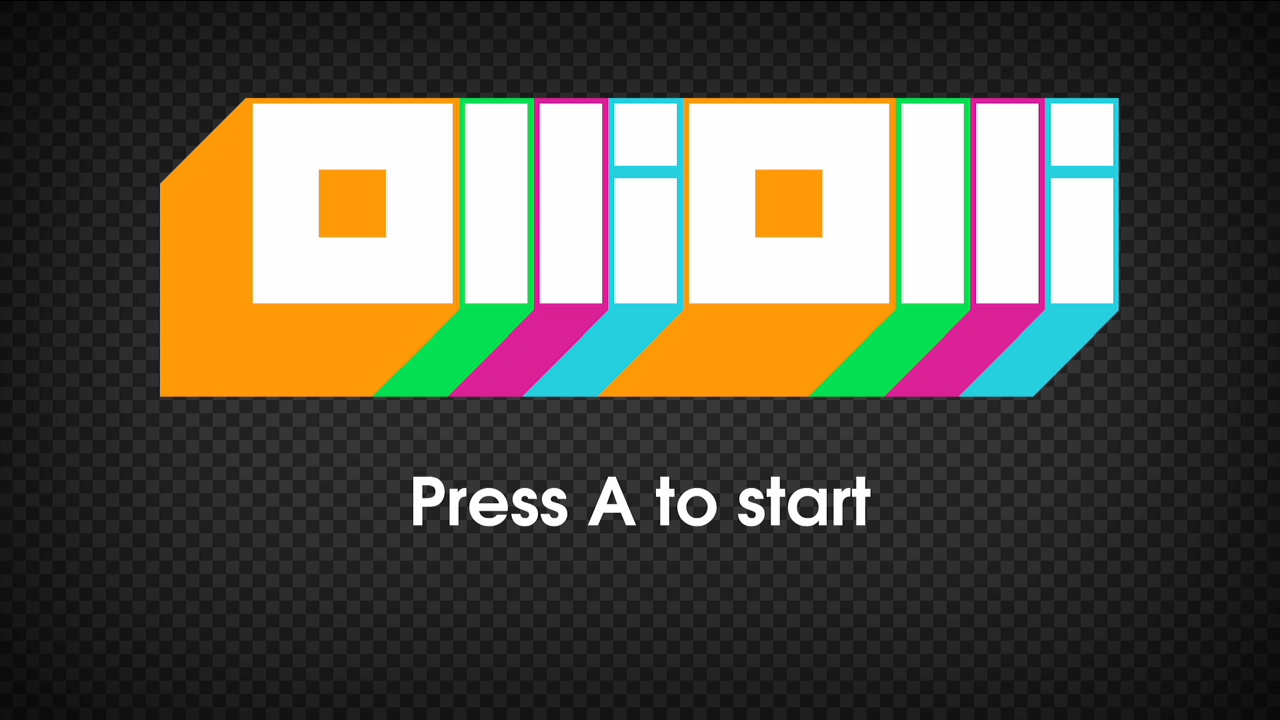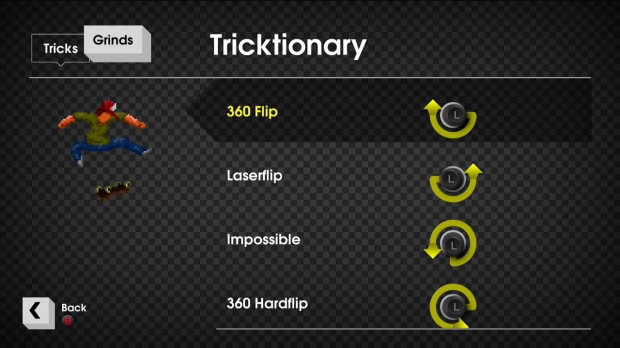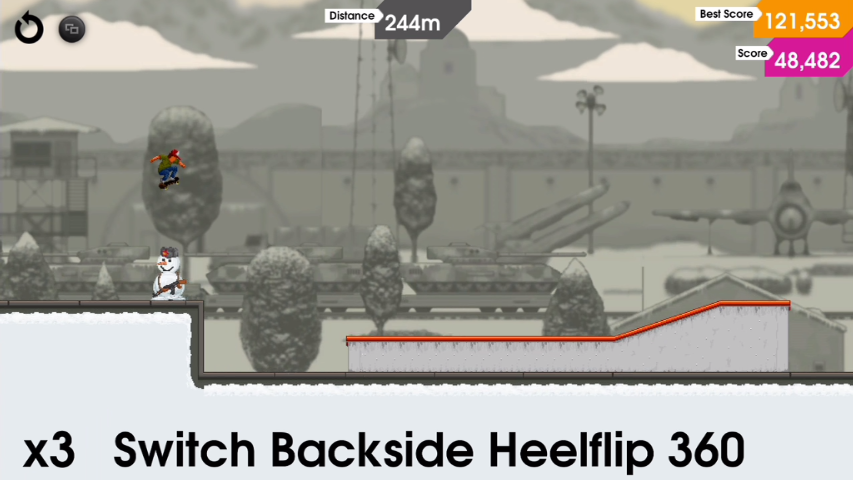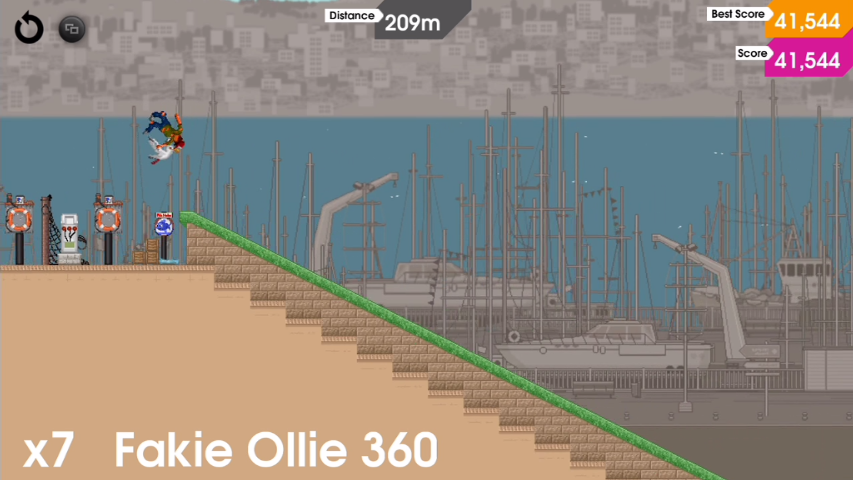OlliOlli review (Xbox One)
OlliOlli was developed by Roll7 and published by Curve Digital on Xbox One. It was released on March 6, 2015 for $8.49 for Xbox Live Gold members and will be $9.99 once the release sale ends. A copy was provided by Curve Digital for review purposes.
OlliOlli is an endless runner skateboarding game that prides itself on using buzz words like “rad” and “sick.” It’s not a mixed bag of tricks, though. With no story and no multiplayer except for limited leaderboard options, there is only one thing to do: perform gnarly stunts and survive levels.
As a forewarning, the graphics are very underwhelming and are border on what might be considered the bare minimum to get by. So much so that when OlliOlli was demonstrated in front of a live audience, multiple people were quick to judge it as a “bad game,” in PG terms, for its graphics alone. Graphics shouldn’t define a game in a negative fashion, though: it’s entirely possible to have a beautiful-looking game and still be unpleasant to play. The inverse is also true; a game can be very basic and still be incredibly fun. Besides, graphics often don’t age well. How will a person look at current modern graphics in 10-20 years from now? Likely not as favorably as they do today. With that out-of-the-way, let’s get started on the features.
Here’s what I liked:
Tricks ‘o plenty — You can perform many different tricks with a different press of the stick. Some tricks are done by holding LB/LT or RB/RT and a direction. Each trick has four variations: regular, switch (a regular trick done in a stance after doing a 180), nollie (done with holding LT/LB + RT/RB and releasing before doing the combination) and fakie (a nollie done in a switch position). In a game that has a competitive leaderboard and penalizes repetitive tricks, a huge repertoire of actions is quite handy. Admittedly, you’ll never use a good 80 percent of them on impulse, but having the option available is nice.
Spots — Spots offer different takes on standard levels. In a regular level, the player rides until crashing or reaching the end of the level. Sometimes there is a lull with nothing but flat ground preparing you for the next part of a level. In Spots, the player rides until landing on the ground for the first time, reaching the end of the level or crashing. Because of the way the rules work, everything in Spots is designed to be able to be comboed on until the end of the level. In that way, it’s a fast-paced non-stop action version of the regular game, and any faults emanate from player actions rather than Roll7 having designed stoppages into the level. It’s fun, and my only gripe is that you have to beat the level before you unlock its Spot version. Given the option, I’d rather just play Spots from the start.
Hidden collectibles — The sadist in me approves of these collectibles and thought of them as a cool concept. Basically, in certain levels, you can take a rail to jump over the crowd (aka the finish line) and continue on through the level and find a hidden collectible. So not only do you have to survive the level, but you have to succeed in taking the extra rail. Compounding things, these extra rails aren’t always easy to see or easy to land on, and you also have to stick the landing behind the crowd as well as survive long enough to collect the hidden collectible. If you miss the extra rail, you’ll either crash or end the level, both of which will force you to try the level again. I’m sure you don’t need me to tell you what happens when you crash before reaching the collectible. I’m also sure most people will be relieved that there are only five of those in the game, but I found the concept to be fun.
Here’s what I didn’t like:
The controls/high learning curve – Ugh. These controls suck so much and single-handedly ruin OlliOlli for many people. Yes, I’ve already heard many complaints about them. These controls are so counter-intuitive that it gives OlliOlli an unnaturally high learning curve for such a simple game. In a similar endless runner skateboarding game on Windows 8 called Endless Skater, you press A to jump, use the stick to apply a trick, press X to apply a flip, Y to grind and B to grab. Let go early enough and you’ll land safely. Nice, simple and easy. How does OlliOlli set itself apart? By being needlessly complicated. You hold the left stick or d-pad for a duration and let go and perform specific directions to jump up and do a trick. You have to press the stick in a direction while attempting to land on a grind rail, and you have to press A before you land on the ground; otherwise you’ll either crash or get a sloppy landing and lose your speed. What the heck? Why was it designed to be so complicated? Holding the directional pad and letting go ensures you can’t easily do split-second jumps in which you sometimes need to jump within a second of landing. Tricks being reliant on stick movements mean if you don’t hold the direction long enough before attempting the trick, you’ll, at best, do the wrong trick and, at worst, do the nothing and ruin your run. When you finally get to pulling off tricks and jumping safely, you have to learn how to land them to maximize points. A low combo with a perfect landing can be worth more than a big combo with an okay or bad landing. Press A prematurely and you’ll get a sloppy landing — even if you press it again with proper timing. Press A even a split second late and you’ll miss with a sloppy landing. Mistime it a bit early and you’ll get a sick landing. Another mechanic in the game is spinning, which helps you score high points but must be released before attempting to land on a rail or the ground. Many sequences go something like this: jump, spin, trick, land, jump, spin, trick, land on grind rail, jump, land. It’s very easy to become disoriented and mess up, but I could forgive the game if it had just the holding the stick mechanic or the pressing A to land mechanic but having both is ridiculous. Some OlliOlli purists will say these controls are fine, but they’re not. They’re horrible.
I hope you like skateboarding for points — Because that is all you’ll be doing here. Each level has five optional objectives ranging from total score, beating a set score in one combo and various other objectives like performing certain tricks, not, scoring higher than x points on every trick (basically any jump is at the very least an Ollie trick) and more. The underlying goal is do tricks, score well and beat the level (sometimes in a specific way). This game needs something else for the player to do, because there isn’t much to go back to. A countdown mode based on balancing direct speed and doing tricks to raise the timer? Maybe a speed run with a requirement of x tricks in a run? OlliOlli needs more options.
Wrap-up:
I did eventually learn the controls and have some fun with OlliOlli. But dang it, I shouldn’t have to fight so hard to control a game. Had the controls been simple, I could easily recommend this game — but they’re not simple. As a result, most gamers will find the experience frustrating and painful, but for the few that can stick with it, there’s a fun time to be had.
Score: Try It
Achievement Notes: With only 12 achievements for the base 1,000 Gamerscore, OlliOlli‘s achievement unlocks are few and far apart. Doing a 540 trick may be the easiest achievement, but it’s not a complete freebie. After that, many people might not stick around to unlock the second achievement for obtaining a 25x combo and completing the level. After that, everything is skill reliant based on dealing with the game’s controls. If you’re expecting easy Gamerscore, you might be looking in the wrong place.





